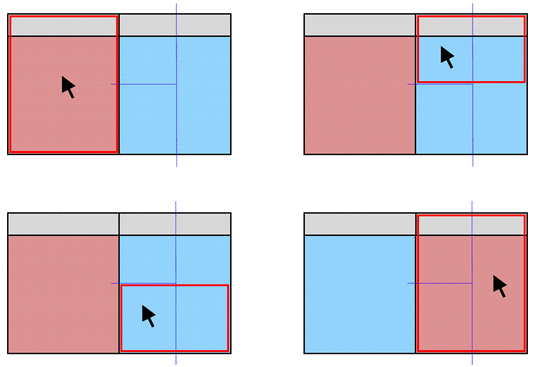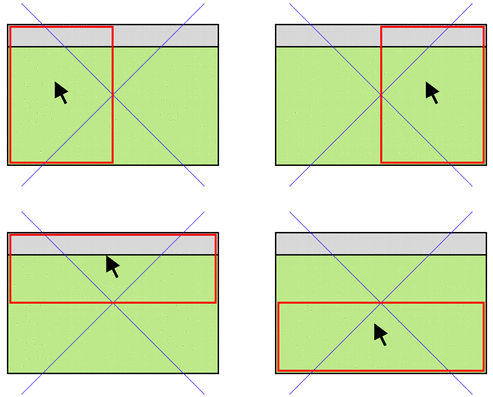| Home · All Classes · Main Classes · Grouped Classes · Modules · Functions |
The QMainWindow class provides a main application window. More...
#include <QMainWindow>
Inherits QWidget.
The QMainWindow class provides a main application window.
QMainWindow provides a main application window, with a menu bar, tool bars, dock widgets and a status bar around a large central widget, such as a text edit, drawing canvas or QWorkspace (for MDI applications).
Note that QMainWindow comes with its own customized layout and that setting a layout on a QMainWindow, or creating a layout with a QMainWindow as a parent is considered an error. You should set your own layout on the central widget instead.
Topics:
The saveState() and restoreState() functions provide a means to save and restore the layout of the QToolBars and QDockWidgets in the QMainWindow. These functions work by storing the objectName of each QToolBar and QDockWidget together with information about placement, size, etc.
QMainWindow uses separators to separate QDockWidgets from each other and the central widget. These separators let the user control the size of QDockWidgets by dragging the boundary between them.
A QDockWidget can be as large or as small as the user wishes, between the minimumSizeHint() (or minimumSize()) and maximumSize() of the QDockWidget. When a QDockWidget reaches its minimum size, space will be taken from other QDockWidgets in the direction of the user's drag, if possible. Once all QDockWidgets have reached their minimum sizes, further dragging does nothing. When a QDockWidget reaches its maximium size, space will be given to other QDockWidgets in the opposite direction of the user's drag, if possible. Once all QDockWidgets have reached their minimum size, futher dragging does nothing.
QDockWidget displays a title bar to let the user drag the dock widget to a new location. A QDockWidget can be moved to any location provided enough space is available. (QMainWindow won't resize itself to a larger size in an attempt to provide more space.)
A QRubberBand is shown while dragging the QDockWidget. This QRubberBand provides an indication to the user about where the QDockWidget will be placed when the mouse button is released.
All un-nested QDockWidgets in the same dock area are considered neighbors. When dragging a QDockWidget over its neighbor:
The following diagram depicts this behavior:

When dragging nested QDockWidgets, or when dragging to a different dock area, QMainWindow will split the QDockWindow under the mouse. Be aware that the QDockWidget under the mouse will only be split by the QDockWidget being dragged if both can fit in the space currently occupied by the QDockWidget under the mouse.
A QDockWidget can be split horizontally or vertically, with the QDockWidget being dragged being placed in one of four possible locations, as shown in the diagram below:

The QDockWidget::floatable property influences feedback when the user drags a QDockWidget over the central widget:
In either case, dragging the mouse over another QDockWidget causes QMainWindow to choose the other QDockWidget's dock area.
When dragging outside the QMainWindow, the QDockWidget::floating property again controls feedback during dragging. When the property is false, dragging outside of the QMainWindow will show the rubberband over the QDockWidget's current location. This indicates that the QDockWidget cannot be moved outside of the QMainWindow. When the QDockWidget::floatable property is true, dragging outside of the QMainWindow will show the QRubberBand under the mouse pointer. This indicates that the QDockWidget will be floating when the mouse button is released.
See also QMenuBar, QToolBar, QStatusBar, and QDockWidget.
This property holds size of toolbar icons in this mainwindow.
The default is the default tool bar icon size of the GUI style.
Access functions:
This property holds style of toolbar buttons in this mainwindow.
The default is Qt::ToolButtonIconOnly.
Access functions:
Constructs a QMainWindow with the given parent and the specified widget flags.
Destroys the main window.
Adds the given dockwidget to the specified area.
This is an overloaded member function, provided for convenience.
Adds dockwidget into the given area in the direction specified by the orientation.
Adds the toolbar into the specified area in this main window. The toolbar is placed at the end of the current tool bar block (i.e. line). If the main window already manages toolbar then it will only move the toolbar to area.
See also insertToolBar(), addToolBarBreak(), and insertToolBarBreak().
This is an overloaded member function, provided for convenience.
Equivalent of calling addToolBar(Qt::TopToolBarArea, toolbar)
This is an overloaded member function, provided for convenience.
Creates a QToolBar object, setting its window title to title, and inserts it into the top toolbar area.
See also setWindowTitle().
Adds a toolbar break to the given area after all the other objects that are present.
Returns the central widget for the main window. This function returns zero if the central widget has not been set.
See also setCentralWidget().
Returns the dock widget area that occupies the specified corner.
See also setCorner().
This function is called to create a popup menu when the user right-clicks on the menu bar, a toolbar or a dock widget. If you want to create a custom popup menu, reimplement this function and return the created popup menu. Ownership of the popup menu is transferred to the caller.
Returns the Qt::DockWidgetArea for dockwidget. If dockwidget has not been added to the main window, this function returns zero.
See also addDockWidget(), splitDockWidget(), and Qt::DockWidgetArea.
This signal is emitted when the size of the icons used in the window is changed. The new icon size is passed in iconSize.
You can connect this signal to other components to help maintain a consistent appearance for your application.
See also setIconSize().
Inserts the toolbar into the area occupied by the before toolbar so that it appears before it. For example, in normal left-to-right layout operation, this means that toolbar will appear to the left of the toolbar specified by before in a horizontal toolbar area.
See also insertToolBarBreak(), addToolBar(), and addToolBarBreak().
Inserts a toolbar break before the toolbar specified by before.
Returns the menu bar for the main window. This function creates and returns an empty menu bar if the menu bar does not exist.
See also setMenuBar().
Removes the dockwidget from the main window layout and hides it. Note that the dockwidget is not deleted.
Removes the toolbar from the main window layout and hides it. Note that the toolbar is not deleted.
Restores the state of this mainwindow's toolbars and dockwidgets. The version number is compared with that stored in state. If they do not match, the mainwindow's state is left unchanged, and this function returns false; otherwise, the state is restored, and this function returns true.
See also saveState().
Saves the current state of this mainwindow's toolbars and dockwidgets. The version number is stored as part of the data.
The objectName property is used to identify each QToolBar and QDockWidget. You should make sure that this property is unique for each QToolBar and QDockWidget you add to the QMainWindow
To restore the saved state, pass the return value and version number to restoreState().
See also restoreState().
Sets the given widget to be the main window's central widget.
Warning: This function should be called at most once for each main window instance
Note: QMainWindow takes ownership of the widget pointer and deletes it at the appropriate time.
See also centralWidget().
Sets the given dock widget area to occupy the specified corner.
See also corner().
Sets the menu bar for the main window to menuBar.
Note: QMainWindow takes ownership of the menuBar pointer and deletes it at the appropriate time.
See also menuBar().
Sets the status bar for the main window to statusbar.
Setting the status bar to 0 will remove it from the main window. Note that QMainWindow takes ownership of the statusbar pointer and deletes it at the appropriate time.
See also statusBar().
Splits the space covered by the first dock widget into two parts, moves the first dock widget into the first part, and moves the second dock widget into the second part.
The orientation specifies how the space is divided: A Qt::Horizontal split places the second dock widget to the right of the first; a Qt::Vertical split places the second dock widget below the first.
Note: The Qt::LayoutDirection influences the order of the dock widgets in the two parts of the divided area. When right-to-left layout direction is enabled, the placing of the dock widgets will be reversed.
Returns the status bar for the main window. This function creates and returns an empty status bar if the status bar does not exist.
See also setStatusBar().
Returns the Qt::ToolBarArea for toolbar. If toolbar has not been added to the main window, this function returns zero.
See also addToolBar(), addToolBarBreak(), and Qt::ToolBarArea.
This signal is emitted when the style used for tool buttons in the window is changed. The new style is passed in toolButtonStyle.
You can connect this signal to other components to help maintain a consistent appearance for your application.
See also setToolButtonStyle().
| Copyright © 2006 Trolltech | Trademarks | Qt 4.1.3 |